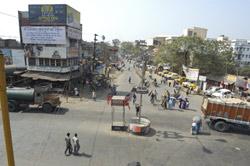Madhyamgram
|
Madhyamgram মধ্যমগ্রাম |
|
|---|---|
| Kolkata Metropolitan | |

Madhyamgram Crossing (Chowmatha) on Jessore Road
|
|
| Location in West Bengal, India | |
| Coordinates: 22°42′N 88°27′E / 22.70°N 88.45°ECoordinates: 22°42′N 88°27′E / 22.70°N 88.45°E | |
| Country | India |
| State | West Bengal |
| District | Number of wards = 28 |
| Government | |
| • Municipality Chairman | Mr. Rathin Ghosh |
| Elevation | 15 m (49 ft) |
| Population (2014[Approx]) | |
| • Total | 175,670 |
| • Rank | 298 |
| Languages | |
| • Official | Bengali, English |
| Time zone | IST (UTC+5:30) |
| PIN | 700129/700130 |
| Telephone code | 91 33 |
| Vehicle registration | WB 26 |
| Lok Sabha constituency | Barasat |
| Vidhan Sabha constituency | Madhyamgram |
Madhyamgram is neighborhood in Kolkata, within the Indian state of West Bengal, and in the urban Metropolitan City Kolkata, having a Calcutta (Kolkata) postal code and telephone zone (33). It is under the jurisdiction of the Barasat sadar subdivision, within the limit of Madhyamgram police stations, and under the local jurisdiction of Madhyamgram Municipality. It is a part of the area covered by Kolkata Metropolitan Development Authority.
Madhyamgram was in the Kingdom of Raja Protapaditya Roy, one of the twelve feudal provinces of Bengal, and Ruler of Jessore during the Mughal regime.
On December 20, 1757 Mirzafar, the Nawab of Bengal, presented twenty-four parganas to the East India Company as dowry which also included Madhyamgram, under Anwarpur Pargana, adjacent to Barasat.
The first railway line from Madhyamgram to Duttapukur was commissioned in 1882, and the station was called Chandipur. Madhyamgram was then named as Majher Gaon, probably because the area was situated between Badu (Chakradharpur Mouza) and Sajirhat (Guchuria Mouza).
The present narrow Noai Canal, now acting as a dividing border line between New Barrackpore and Madhyamgram, stretching from the South of Ganganagar to Sajirhat in the West used to be a wide river, once called Labanyabati, which through colloquial transformation became the Noai River, and after years of silt depositions, turned into Noai Canal.
At that time, Anwarpur Pargana was famous for its tobacco trade and a special sweet-smelling blended tobacco was manufactured in Madhyamgram.
Madhyamgram was also a big paddy growing area, and the Labanya River was a medium of navigation for the exportation of those products. Madhyamgram was also famous for its fine embroidery works that attracted appreciation from Delhi and Mumbai. Many Muslim families maintained a livelihood through those works.
The climate is tropical, like the rest of the Gangetic West Bengal. The hallmark season is the Monsoon—which occurs from early June to mid September. The weather remains dry during the winter (mid-November to mid-February) and humid during summer.
...
Wikipedia

